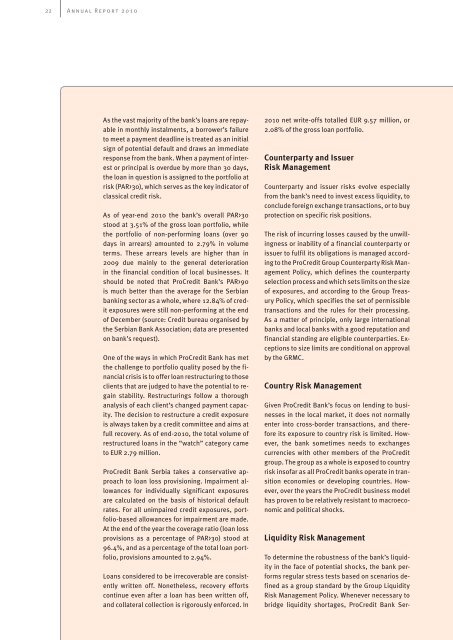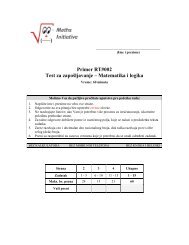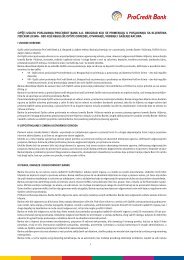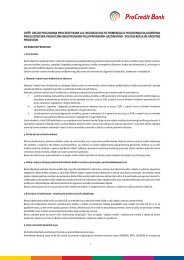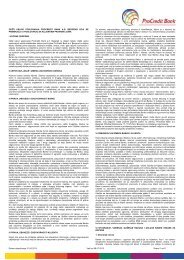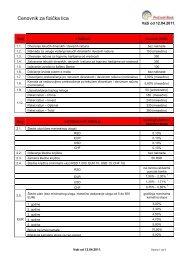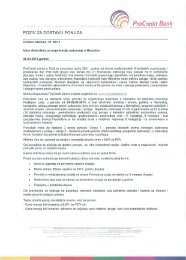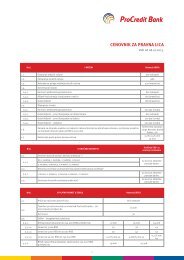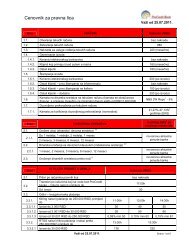Annual Report 2010 - ProCredit Bank
Annual Report 2010 - ProCredit Bank
Annual Report 2010 - ProCredit Bank
- No tags were found...
You also want an ePaper? Increase the reach of your titles
YUMPU automatically turns print PDFs into web optimized ePapers that Google loves.
22<br />
<strong>Annual</strong> <strong>Report</strong> <strong>2010</strong><br />
As the vast majority of the bank’s loans are repayable<br />
in monthly instalments, a borrower’s failure<br />
to meet a payment deadline is treated as an initial<br />
sign of potential default and draws an immediate<br />
response from the bank. When a payment of interest<br />
or principal is overdue by more than 30 days,<br />
the loan in question is assigned to the portfolio at<br />
risk (PAR>30), which serves as the key indicator of<br />
classical credit risk.<br />
As of year-end <strong>2010</strong> the bank’s overall PAR>30<br />
stood at 3.51% of the gross loan portfolio, while<br />
the portfolio of non-performing loans (over 90<br />
days in arrears) amounted to 2.79% in volume<br />
terms. These arrears levels are higher than in<br />
2009 due mainly to the general deterioration<br />
in the financial condition of local businesses. It<br />
should be noted that <strong>ProCredit</strong> <strong>Bank</strong>’s PAR>90<br />
is much better than the average for the Serbian<br />
banking sector as a whole, where 12.84% of credit<br />
exposures were still non-performing at the end<br />
of December (source: Credit bureau organised by<br />
the Serbian <strong>Bank</strong> Association; data are presented<br />
on bank’s request).<br />
One of the ways in which <strong>ProCredit</strong> <strong>Bank</strong> has met<br />
the challenge to portfolio quality posed by the financial<br />
crisis is to offer loan restructuring to those<br />
clients that are judged to have the potential to regain<br />
stability. Restructurings follow a thorough<br />
analysis of each client’s changed payment capacity.<br />
The decision to restructure a credit exposure<br />
is always taken by a credit committee and aims at<br />
full recovery. As of end-<strong>2010</strong>, the total volume of<br />
restructured loans in the “watch” category came<br />
to EUR 2.79 million.<br />
<strong>ProCredit</strong> <strong>Bank</strong> Serbia takes a conservative approach<br />
to loan loss provisioning. Impairment allowances<br />
for individually significant exposures<br />
are calculated on the basis of historical default<br />
rates. For all unimpaired credit exposures, portfolio-based<br />
allowances for impairment are made.<br />
At the end of the year the coverage ratio (loan loss<br />
provisions as a percentage of PAR>30) stood at<br />
96.4%, and as a percentage of the total loan portfolio,<br />
provisions amounted to 2.94%.<br />
Loans considered to be irrecoverable are consistently<br />
written off. Nonetheless, recovery efforts<br />
continue even after a loan has been written off,<br />
and collateral collection is rigorously enforced. In<br />
<strong>2010</strong> net write-offs totalled EUR 9.57 million, or<br />
2.08% of the gross loan portfolio.<br />
Counterparty and Issuer<br />
Risk Management<br />
Counterparty and issuer risks evolve especially<br />
from the bank’s need to invest excess liquidity, to<br />
conclude foreign exchange transactions, or to buy<br />
protection on specific risk positions.<br />
The risk of incurring losses caused by the unwillingness<br />
or inability of a financial counterparty or<br />
issuer to fulfil its obligations is managed according<br />
to the <strong>ProCredit</strong> Group Counterparty Risk Management<br />
Policy, which defines the counterparty<br />
selection process and which sets limits on the size<br />
of exposures, and according to the Group Treasury<br />
Policy, which specifies the set of permissible<br />
transactions and the rules for their processing.<br />
As a matter of principle, only large international<br />
banks and local banks with a good reputation and<br />
financial standing are eligible counterparties. Exceptions<br />
to size limits are conditional on approval<br />
by the GRMC.<br />
Country Risk Management<br />
Given <strong>ProCredit</strong> <strong>Bank</strong>’s focus on lending to businesses<br />
in the local market, it does not normally<br />
enter into cross-border transactions, and therefore<br />
its exposure to country risk is limited. However,<br />
the bank sometimes needs to exchanges<br />
currencies with other members of the <strong>ProCredit</strong><br />
group. The group as a whole is exposed to country<br />
risk insofar as all <strong>ProCredit</strong> banks operate in transition<br />
economies or developing countries. However,<br />
over the years the <strong>ProCredit</strong> business model<br />
has proven to be relatively resistant to macroeconomic<br />
and political shocks.<br />
Liquidity Risk Management<br />
To determine the robustness of the bank’s liquidity<br />
in the face of potential shocks, the bank performs<br />
regular stress tests based on scenarios defined<br />
as a group standard by the Group Liquidity<br />
Risk Management Policy. Whenever necessary to<br />
bridge liquidity shortages, <strong>ProCredit</strong> <strong>Bank</strong> Ser-


